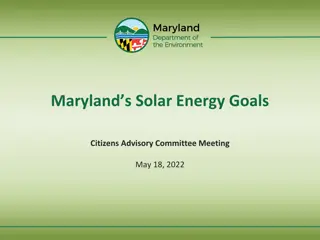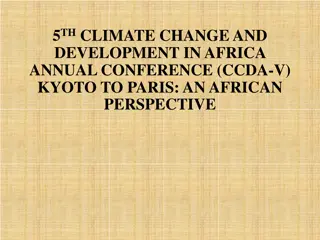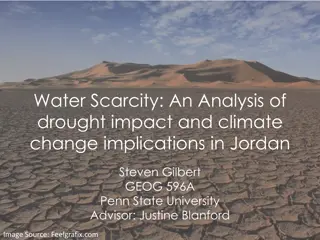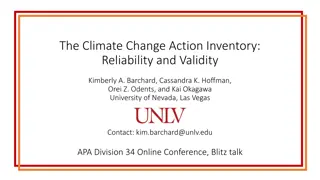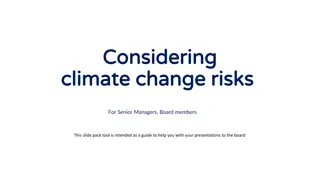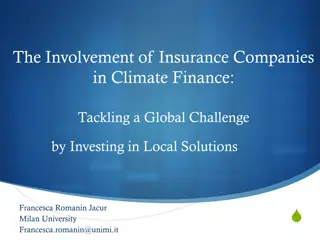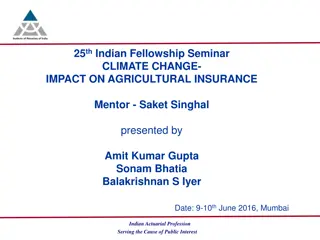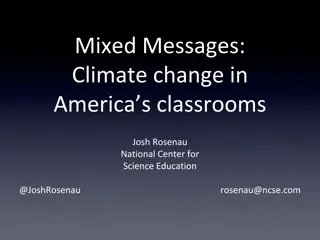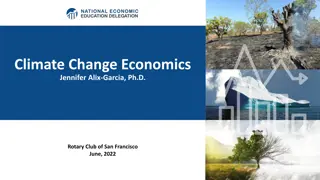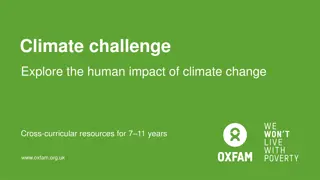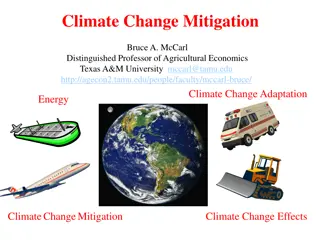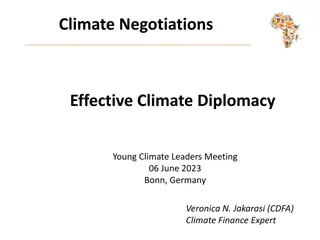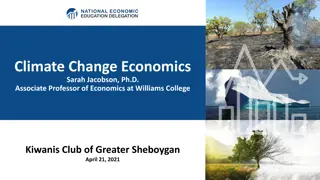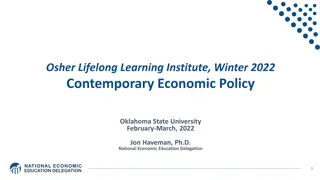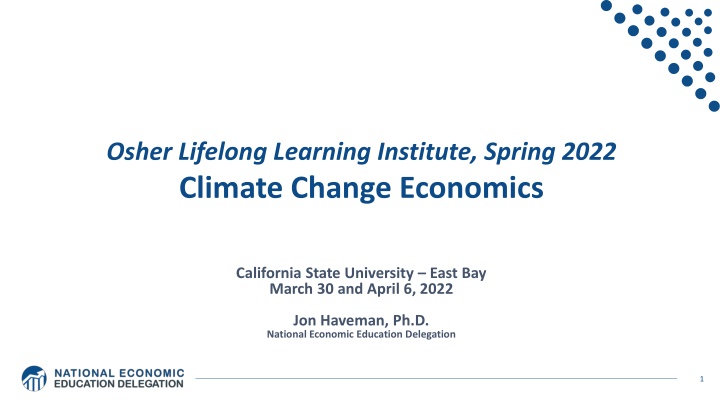
Climate Change Economics at Osher Institute Spring 2022
Osher Lifelong Learning Institute's Spring 2022 session delves into the economic aspects of climate change. Explore the impact of climate change, economic responses, and policies to mitigate emissions. Get insights from experts like Jon Haveman, Ph.D., and delve into the crucial connections between economics and climate change policy.
Uploaded on | 1 Views
Download Presentation

Please find below an Image/Link to download the presentation.
The content on the website is provided AS IS for your information and personal use only. It may not be sold, licensed, or shared on other websites without obtaining consent from the author. If you encounter any issues during the download, it is possible that the publisher has removed the file from their server.
You are allowed to download the files provided on this website for personal or commercial use, subject to the condition that they are used lawfully. All files are the property of their respective owners.
The content on the website is provided AS IS for your information and personal use only. It may not be sold, licensed, or shared on other websites without obtaining consent from the author.
E N D
Presentation Transcript
Osher Lifelong Learning Institute, Spring 2022 Climate Change Economics California State University East Bay March 30 and April 6, 2022 Jon Haveman, Ph.D. National Economic Education Delegation 1
National Economic Education Delegation Vision - One day, the public discussion of policy issues will be grounded in an accurate perception of the underlying economic principles and data. Mission - NEED unites the skills and knowledge of a vast network of professional economists to promote understanding of the economics of policy issues in the United States. NEED Presentations - Are nonpartisan and intended to reflect the consensus of the economics profession. 2
Who Are We? Honorary Board: 54 members - 2 Fed Chairs: Janet Yellen, Ben Bernanke - 6 Chairs Council of Economic Advisers o Furman (D), Rosen (R), Bernanke (R), Yellen (D), Tyson (D), Goolsbee (D) - 3 Nobel Prize Winners o Akerlof, Smith, Maskin Delegates: 651+ members - At all levels of academia and some in government service - All have a Ph.D. in economics - Crowdsource slide decks - Give presentations Global Partners: 49 Ph.D. Economists - Aid in slide deck development 3
Available NEED Topics Include: Coronavirus Economics Immigration Economics US Economy Housing Policy Climate Change Federal Budgets Economic Inequality Federal Debt Economic Mobility Black-White Wealth Gap Trade and Globalization Autonomous Vehicles Minimum Wages US Social Policy 5
Credits and Disclaimer This slide deck was authored by: - Shana Mcdermott, Trinity University - Sarah Jacobson, Williams College - Sharon Shewmake, Western Washington University This slide deck was reviewed by: - Jason Shogren, University of Wyoming - Walter Thurman, North Carolina State University Disclaimer - NEED presentations are designed to be nonpartisan. - It is, however, inevitable that the presenter will be asked for and will provide their own views. - Such views are those of the presenter and not necessarily those of the National Economic Education Delegation (NEED). 6
Outline Climate change science Impacts of climate change Economics of responding to climate change Addressing the sources of our emissions Climate change policy Policy in action
Economics Informs Almost Everything Prices Incentives Externalities Cost-Benefit Analysis Growth Inflation Interest Rates Climate Change International Trade Immigration Housing Education Health Care Gun Control 8
How Can Economists Contribute to Thinking about Climate Change? By assessing behavioral reactions to climate change. By measuring the damage and estimating the economic costs of fighting climate change. By designing smart policies that minimize costs. - Balance economic growth with GHG emission mitigation. 9
Climate Change: A Little Science
The Atmospheric Greenhouse Effect Sun Atmosphere Light reflected back onto earth Light reflected back into space
Uncertainty ? ? ?
Atmospheric CO2 Concentrations Up To Now Source: NOAA
Emissions Trajectories into the Future Source: IPCC Assessment Report 5
What Do Greenhouse Gas Emissions Do to the Planet? Increased temperatures - Sea level rise - Storm surges Altered precipitation patterns More variable weather More / more powerful storms Carbon dissolves in ocean 15
Icebergs Are Significant Contributors 16 https://www.scientificamerican.com/article/what-to-know-about-antarcticas-conger-ice-shelf-collapse/
The Earth is Clearly Warming Global Average Surface Temperature 17
How These Impacts Affect Humans Reduced fresh water availability Wildfires Shifting zones for important ecosystems, and desertification Reduced worker productivity Increased violence Some of these may cause human migration and/or conflict Agriculture Fisheries Coastal damages Direct health effects, including sickness and death (temperature & drought; also pollution) Indirect health effects (vector- borne disease)
How Damages Will Vary Globally: Mortality as an Example 21
Projected Effects Vary Across the U.S. but Are Estimated at 1.2% of GDP per 1C Increase
Most Vulnerable People and Places Tropical areas Low-lying coastal areas Low-income people
26 https://www.brookings.edu/research/ten-facts-about-the-economics-of-climate-change-and-climate-policy/
A Climate Change Ladder Emissions Mitigation (a.k.a. Abatement) Adaptation Damages 29
Total U.S. Greenhouse Gas Emissions by Economic Sector in 2020
A Climate Change Ladder Emissions Mitigation (a.k.a. Abatement) Adaptation Damages 37
Econ 101: When Everything Is Simple, No Regulation Is Needed for Efficiency Simple transactions: buyer and seller feel all costs and benefits of sales They choose based on the costs & benefits they feel Efficient number of transactions! (Maximizes social benefits) 39
How Much Pollution Does Society Want? Analogy: How Many Oranges Does Society Want? People grow and sell oranges for a price that at least covers costs (supply). People will not pay more for them than what they consider to be their value (demand). Prices let supply and demand balance out. The price settles where: # of oranges people want to sell = # of oranges people want to buy This is the right number of oranges for society. Prices reflect scarcity and the social value of the resource.
The First Theorem of Welfare Economics is that private markets are perfectly efficient on their own, with no interference from government, provided certain conditions are met. Economic Efficiency: When the sum of the profits of buyers and the profits of sellers is maximized. *You can t make anyone better off without making someone worse off. 41
What are certain conditions? No public goods No information problems No externalities No taxes No monopoly buyers or sellers No transaction costs No common property No increasing returns to scale No other distortions between the costs paid by buyers and the benefits received by sellers.
Characteristics of Goods Excludable: Goods that you can exclude people from using. Rival: One person s use of the good diminishes other s ability to use the good. Public Goods (Not Rival or Excludable): Benefits additional users at no cost to society. Common Resources (Rival, but not Excludable): Common property, or open access resources, where anyone can extract or harvest the resource freely and no one recognizes the full cost of using the resource. 43
Characteristics of Goods & Environmental Economics Externalities: some costs or benefits of producing, consuming, or disposing of a good or service are external to the market. Missing Markets Problem: some goods (or inputs) into production are not sold on a market. Firms and individuals then sometimes value the good at what they pay for it, $0, instead of what it is worth. 44
Examples of Externalities Negative Externalities: Positive Externalities - Heating your house - Education - Smoking - Growing apples - Getting a dog - Getting a vaccination - Pig farming - Basic scientific research 45
Pigouvian Taxes Internalize negative externalities. - Make the buyers of the good that produces an externality pay for the externality. o Creates a market of sorts for the externality. Government is the caretaker of clean air, for example. Cigarette s pollute the air, so smokers pay the government for the right to pollute the air. It does this by equalizing marginal social cost (MSC) with marginal social benefit (MSB) . - With no externality: - With a negative externality: o My actions cost society more than I am paying to undertake them. MSB = MSC MSB < MSC 46
Marginal Social Cost and Social Benefit? Marginal: refers to the costs and benefits of the last unit sold. Marginal Cost (MC): refers to the cost of making the last unit sold. Marginal Benefit (MB): refers to the value the consumer puts on buying the last unit. Social cost: the impact, in dollar terms, of consuming the last unit sold. With a negative externality: o MSB = MB o MSC = MC + Social cost 47
How Does A Pigouvian Tax Work? A market with no externalities. Oranges Price Supply =MC =MSC MSC = MC MSB = MB Economically Efficient Equilibrium Market Price = P MSB = MSC Demand =MB =MSB No Pigouvian tax is necessary. Number Sold Quantity 48
How Does A Pigouvian Tax Work? Supply =MSC = MC + x A market with a negative externality. Cigarettes Price x Supply =MC X = social cost MSC = MC+x Pigouvian Tax = x New P+x MSB = MB Economically Efficient Equilibrium x P MSB < MSC New P A Pigouvian tax is necessary to set MSB = MSC. Demand =MB =MSB Number Sold Quantity 49
How Does A Pigouvian Tax Work? 1) A Pigouvian tax raises the cost of buying the item. 2) The higher cost results in less of the item being purchased. 3) With lower consumption, comes less of the externality. Key: Consumer is now paying for all of the costs associated with the good. Note: the tax REDUCES the amount of the externality. It does not eliminate it. How much of a cost should we bear to get rid of a $5 externality? Answer: $5 50




